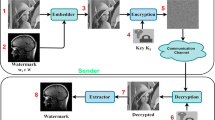Abstract
Watermarking is the most widely used technology in the field of copyright and biological information protection. In this paper, we use quantization based digital watermark encryption technology on the Electrocardiogram (ECG) to protect patient rights and information. Three transform domains, DWT, DCT, and DFT are adopted to implement the quantization based watermarking technique. Although the watermark embedding process is not invertible, the change of the PQRST complexes and amplitude of the ECG signal is very small and so the watermarked data can meet the requirements of physiological diagnostics. In addition, the hidden information can be extracted without knowledge of the original ECG data. In other words, the proposed watermarking scheme is blind. Experimental results verify the efficiency of the proposed scheme.








Similar content being viewed by others
References
Anand, D., and Niranjan, U. C., Watermarking medical images with patient information. in:Proceedings of the 20th Annual International Conference of the IEEE Engineering in Medicine and Biology Society, Hong Kong, China, 29 Oct.-1 Nov. 2:703–706, 1998.
Kong, X., and Feng, R., Watermarking Medical Signals for Telemedicine. IEEE Transactions on Information Technology in Biomedicine 5(3):195–201, 2001.
Engin, M., Çidam, O., and Engin, E. Z., Wavelet transformation based watermarking technique for human electrocardiogram (ECG). Journal of Medical Systems 29(6):589–594, 2005.
Nambakhsh, M. S., Ahmadian, A., Ghavami, M., Dilmaghani, R. S., and Karimi-Fard, S., A novel blind watermarking of ECG signals on medical images using EZW algorithm. in:Proceedings of the 28th Annual International Conference of the IEEE Engineering in Medicine and Biology Society (EMBS’06), New York, USA, 30 Aug- 3 Sept 1:3274–3277, 2006.
Zheng KM, Qian X (2008) Reversible data hiding for electrocardiogram signal based on wavelet transforms. In: Proceedings of the2008 International Conference on Computational Intelligence and Security (CIS2008), Suzhou, China,, 13–17 Dec., pp. 295–299.
Zheng, K. M., Tang, L. W., and Qian, X., Watermarking technology for electrocardiogram signal certification. Computer Engineering and Applications 45(20):231–233, 2009.
Kozat, S. S., Vlachos, M., Lucchese, C., Van Herle, H., and Yu, P. S., Embedding and Retrieving Private Metadata in Electrocardiograms. Journal of Medical Systems 33(4):241–259, 2009.
Kaur S, Farooq O, Singhal R, Ahuja BS (2010) Digital watermarking of ECG data for secure wireless communication. In: Proceedings of the 2010 International Conference on Recent Trends in Information, Telecommunication and Computing (ITC2010), Kochi, Kerala, India, 12–13 March, pp. 140–144.
Ibaida A, Khalil I, van Dhiah AS (2010) Embedding Patients Confidential Data in ECG Signal for HealthCareInformation System. In: Proceeding of the 32nd Annual International Conference of the IEEE EMBS, Buenos Aires, Argentina, 31 Aug.-4 Sept., pp. 3891–3894.
Ibaida A, Khalil I, van Schyndel R (2011) A low complexity high capacity ECG signal watermark for wearable sensor-net health monitoring system. In: Proceedings of the Computing in Cardiology (CinC), Hangzhou, China, 18–21 Sept., pp. 393–396.
He X, Tseng KK, Huang HH, Chen ST, Tu SY, Zeng F, Pan JS (2012) Wavelet-based Quantization Watermarking for ECG Signals. In: 2012 International Conference on Computing, Measurement, Control and Sensor Network (CMCSN), Taiyuan, China, July 7–9, pp. 233–236
Guo, Y., and Zhou, D., Single channel surface electromyography blind recognition model based on watermarking. Journal of Vibration and Control 18(1):42–47, 2012.
Dey N, Biswas S, Roy AB, Das A, Chowdhuri SS (2012) Analysis of Photoplethysmographic Signals Modified by Reversible Watermarking Technique using Prediction-Error in Wireless Telecardiology. First International Conference on Intelligent Infrastructure the 47th Annual National Convention at COMPUTER SOCIETY of INDIA CSI, http://http://csidl.org/handle/123456789/433.
Dey, N., Mukhopadhyay, S., Das, A., and Chaudhuri, S. S., Analysis of P-QRS-T Components Modified by Blind Watermarking Technique Within the Electrocardiogram Signal for Authentication in Wireless Telecardiology Using DWT. I. J. Image, Graphics and Signal Processing 4(7):33–46, 2012.
AI Ameen, M., Liu, J., Kwak, K., AI Ameen, M., Liu, J., and Kwak, K., Security and Privacy Issues in Wireless Sensor Networks for Healthcare Applications. Journal of Medical Systems 36(1):93–101, 2012.
Ayman, I., and Ibrahim, K., Wavelet-Based ECG Steganography for Protecting Patient Confidential Information in Point-of-Care Systems. IEEE Transactions on Biomedical Engineering 60(12):3322–3330, 2013.
Lu, C., Wu, Z., Liu, M., Chen, W., and Guo, J., A Patient Privacy Protection Scheme for Medical Information System. Journal of Medical Systems 37(6):9982, 2013.
Huang, J., Wang, Y., and Shi, Y. Q., A blind audio watermarking algorithm with self-synchronization. Proceedings of 2002 I.E. International Symposiumon Circuits and Systems (ISCAS 2002), Scottsdale, Arizona, May 26–29 3:627–630, 2002.
Chen, S. T., Wu, G. D., and Huang, H. N., Wavelet-domain audio watermarking scheme using optimization-based quantization. IET Proceedings on Signal Processing 4(6):720–727, 2010.
Moody, G. B., and Mark, R. G., The impact of the MIT-BIH arrhythmia database. IEEE Engineering in Medicine and Biology Magazine 20(3):45–50, 2001.
Author information
Authors and Affiliations
Corresponding author
Additional information
This article is part of the Topical Collection on Mobile Systems
Rights and permissions
About this article
Cite this article
Chen, ST., Guo, YJ., Huang, HN. et al. Hiding Patients Confidential Datainthe ECG Signal viaa Transform-Domain Quantization Scheme. J Med Syst 38, 54 (2014). https://doi.org/10.1007/s10916-014-0054-9
Received:
Accepted:
Published:
DOI: https://doi.org/10.1007/s10916-014-0054-9




